Recent Articles
Popular Makes
Body Types
Road Test and Review - 2012 Ford Fiesta SE Hatchback

For many years Ford avoided the subcompact segment, preferring to tempt shoppers with the Ford Focus - a compact tweener that could be ordered in a variety of body styles ranging from a tiny two-door hatch all the way up to a four-door wagon. Nowadays, however, there's plenty of coin to be made in the realm of entry-level, ultra-efficient basic transportation, which happens to be an area of the market Ford has extensive experience in across the Atlantic.
Enter the 2012 Ford Fiesta - a model that had long been a mainstay of the Blue Oval's European portfolio, but one that had been kept from American buyers who were previously deemed to be uninterested in its modest dimensions. Now that it's here, Ford has a significant leg-up on its domestic rivals as the Fiesta's international reputation has created a healthy buzz for the hatchback and sedan editions of the automobile in the United States. In a refreshing turn of events, much of the praise that has been heaped on the Ford has been validated by the week we spent with our 2012 Ford Fiesta test car.
2012 Ford Fiesta: Competition
The 2012 Ford Fiesta does battle against the strongest crop of subcompact automobiles to have ever been made available in North America. The Fiesta stares down a list of competitors that includes the equally fresh Chevrolet Sonic, the Hyundai Accent, the Honda Fit and the Kia Rio. Of these options, only the Fit is not available in both hatchback and sedan models, which makes the choice that much harder.
With the majority of car companies having now realized that inexpensive cars no longer have to be dynamic penalty boxes, and a large portion of the public coming around to the idea that the terms 'fun' and 'affordable' don't have to be exclusive, the Fiesta is well positioned to lure buyers who would have previously only considered a small import.
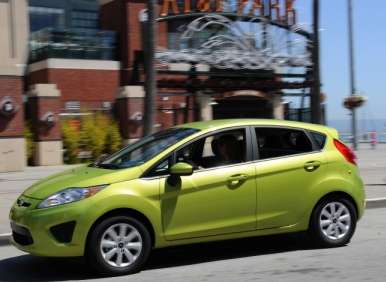
2012 Ford Fiesta: Pricing and Trim Levels
The 2012 Ford Fiesta's pricing is divided along the two different body styles. The Ford Fiesta S sedan starts at an MSRP of $13,745, while the Fiesta S hatchback goes for $14,645. Each is also available in SE trim, while the top of the line sedan is known as the Fiesta SEL and retails for an MSRP of $17,145. The Fiesta SES represents the apex of the hatch model and costs $18,045.
Our test vehicle was a Ford Fiesta SE hatchback outfitted with a number of options packages that brought the total MSRP to $16,635.
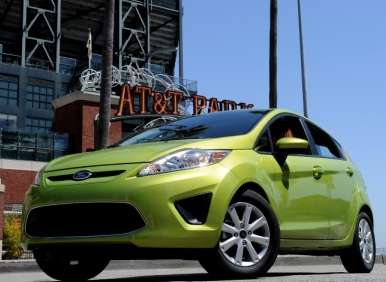
2012 Ford Fiesta: Exterior
The 2012 Ford Fiesta presents an interesting collection of styling cues that walks the line between 'look at me' sport compact flare and the kind of straight-forward presentation that has traditionally been the province of American subcompact cars. Our Fiesta SE was finished in a pleasing, basic white, which served to mute the large lower grille opening and the sizable 'air intakes' positioned on the front fascia below each headlight. Still, nods to youth culture such as LED running lights in place of fog lamps and a large, black spoiler extending past the Fiesta's roof were present and account for.
Perhaps the most obvious shout-out to the twenty-something shoppers that Ford is hoping to attract with the Fiesta were the tribal 'graphics' affixed on either side of the automobile's rear quarter panels and doors. The black swirls and curves, within which lurked the FIESTA name, drew many comments - both positive and negative - from passengers and passersby. The sporty alloy rims that came with the subcompact were also eye-catching enough to be the subject of discussion amongst several of the people we encountered while driving the car.

2012 Ford Fiesta: Interior
The inside of the 2012 Ford Fiesta is for the most part well executed. The gauges found directly ahead of the driver are easy to read, the lighting controls are straightforward, and everything falls to hand without requiring any major stretching. The vehicle's center stack, however, is not nearly as intuitive. The large climate controls at its base are a good match for the vehicle's price point, but the problems start in the middle, where Ford has installed a V-shaped array of buttons that are intended to allow occupants to interact with the Fiesta's SYNC system which is in charge of entertainment and communications duties for the automobile.
The left side of the 'V' features a series of buttons labeled 'CD,' 'RADIO,' 'AUX,' 'PHONE,' and the like. The right side is devoted to a numeric keypad, while the center contains a volume knob as well as a joystick-like button that is designed to function as a navigation tool when parsing the menus of the red-on-black LCD screen at the top of the stack.
Several of our drivers had difficulty understanding how to properly use the joystick, as up and down motions frequently had the effect of accidentally pushing the OK button on the middle and selecting a random menu choice. The menus themselves did not always seem logical in how they were laid out, or how they affected each particular aspect of the SYNC system - for example, the Bluetooth phonebook and Phone settings were located in the same set of menus. This made the system frustrating and clunky to use, especially when trying to guess how a particular menu item would affect the stereo or communications system. None of us were able to consistently interact with the SYNC system using voice commands, and most confusing of all, changing the vehicle's language settings had no effect on the language that SYNC prompts, commands and messages were presented in, requiring us to go through several menus within SYNC in order to set both the Fiesta and SYNC to English.
Another minor annoyance with the SYNC feature was the fact that plugging a device into the AUX input did not always result in it being recognized by the stereo. This was particularly true after having turned the vehicle on or off, required drivers to turn the stereo on and off as well in order to get sound to flow through the Fiesta's audio input.
In terms of materials, the 2012 Ford Fiesta's door panels, armrests, controls, and seats felt appropriate for the automobile's asking price, with no complaints from any passengers regarding the hatchback's comfort level. Our tester came with a fun ambient interior lighting feature that offered several driver-selectable colors that could be used to highlight the vehicle's foot wells, its dashboard, and a few other aspects of the cockpit. Interior room was good up front, and acceptable in the rear, and it was easy enough to fold down the second row of seating to open up cargo space for hauling larger items, although it was necessary to be careful when raising the seat back up to not catch the seatbelt and pin it behind the back of the second row, making it unusable for passengers. The cargo cover that came with our Fiesta tester also frequently came off of its track, leading to 'Trunk Not Closed' messages on the vehicle display whenever the hatch was closed without it being perfectly in place.
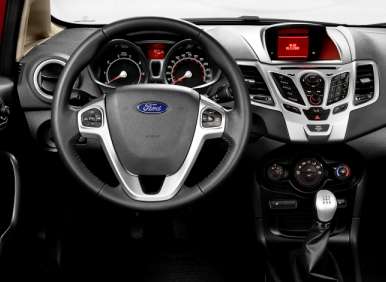
2012 Ford Fiesta: Powertrain and Fuel Economy
The 2012 Ford Fiesta is outfitted with a 1.6-liter, four-cylinder engine that generates 120 horsepower and 112 lb-ft of torque. The unit can be matched to either a five-speed manual or a six-speed dual-clutch automated manual transmission (the Fiesta we were driving featured the traditional manual gearbox). Fuel mileage for the vehicle checks in at 29-mpg in stop and go driving and 38-mpg on the highway, with the latter figure rising to 40-mpg when the SFE package is ordered with the vehicle.
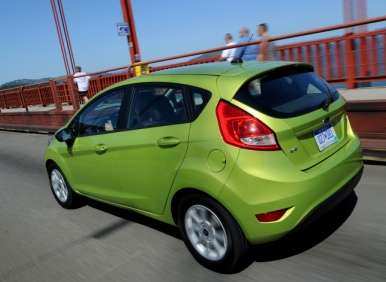
2012 Ford Fiesta: Driving Impressions
The 2012 Ford Fiesta is a fun car to drive. The vehicle's 1.6-liter motor gives it just enough motivation to be interesting without providing the temptation to light up the tires or introducing any distracting torque steer, and the hatchback's light curb weight means that it never feels underpowered when it comes time to pull out and pass. Lightness is also a factor in the Fiesta's maneuverability. The suspension system tucked under the Fiesta does a very capable job of not only absorbing bumps in the road without too much associated jostling of the automobile's human contents, but also of providing a level of feedback that is surprising given the vehicle's low price. The automobile eagerly turns into each corner, and while its limits are quite evident at higher speeds it never exhibits any nervous behavior that would give drivers pause when pushing it hard. The one area where the Fiesta falls down dynamically has to do with the electric assist for its power steering system, which can feel vague while parking or pulling through a slow turn.
The Fiesta's transmission was also a revelation. Each gear change was quick and crisp, with short throws making it easy to move from first to fourth in rapid succession. The Fiesta SE we were driving came with a shift light that would illuminate inside the speedometer cluster at surprisingly low rpms, but following its instructions result in no real loss of performance compared to revving higher in a given gear, indicating that the four-cylinder motor has more torque down low that suspected. Noise inside the cabin while underway was pleasantly muted, and even the engine itself did not intrude too much on the quiet thoughts of those riding inside the hatch.
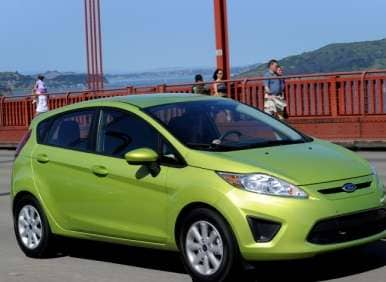
2012 Ford Fiesta: Safety
The 2012 Ford Fiesta is equipped with forward airbags, seat-mounted side airbags for those riding up front, a driver's side knee airbag, and side curtain airbags that deploy along the entire length of the passenger compartment. Electronic stability control, traction control, and a tire pressure monitoring system also come with the subcompact car, and antilock brakes are of course standard.
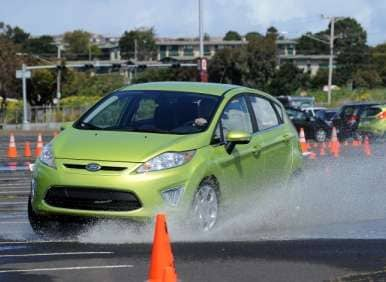
2012 Ford Fiesta: Final Thoughts
The 2012 Ford Fiesta is a very good subcompact car in a field filled with very good subcompact cars. Rewarding to drive, comfortable, fuel efficient, and inexpensive are all very strong qualities for anyone shopping for a small hatchback. Ultimately, the decision as to whether the Fiesta is the car that will be parked in a given driveway will most likely come down to styling, as personal preference will play a significant role in judging whether the Fiesta's looks will age well or become a reminder of a very specific era in subcompact design. On paper - and from behind the wheel - there are very few negative things to say about the hatch's performance, and while the SYNC system might not be perfect, it won't be a deal-breaker for most buyers.
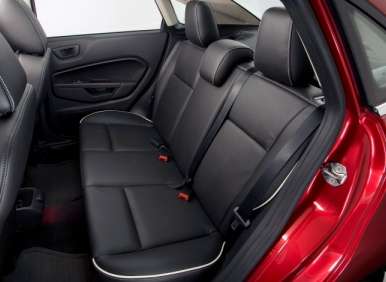
What We Like About The 2012 Ford Fiesta:
- Nimble, fun-to-drive personality
- Reasonably comfortable for its price
- Very fuel efficient without being slow
We Aren't So Hot On:
- Difficult to use SYNC system
- Confusing center stack layout
